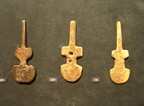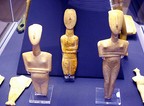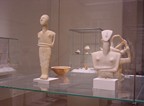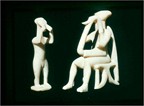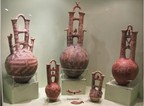Cycladic art mainly used small marble figures which were from the Bronze Age about 3000 BC. This was a finding made commonly by inhabitants of the thirty small cycladic islands of Aegean Sea in Greece. According to studies, Cycladic culture is considered to be the forerunner of the later classical Greek civilization. As much as these people were pre-literate their knowledge of culture was sketchy and was largely based on pure speculation.
Cycladic culture and its art flourished during the Bronze Age. They were very unique and more unique than any other art in that time. This is a finding that is still seen in many everyday objects that were in use from that period. Cycladic art included bottles, pottery and vases. However, the art gained its popularity from its portrayal of human form- its expression and interpretation.
At that time fine marble was not in short supply in the islands. This gave the inhabitants of cycladic islands in Greece the affordability they needed to create statues and figures. The most widely admired source of inspiration of Cycladic art was the sculpture of nude female form. Most of the discovered sculptures from burial sites were of female forms. In cases where the sculptures were those of male forms, they were depicted as warriors, hunters or musician. There are also cases where animal sculptures were recovered.
The most dominant artistic source of inspiration was however the nude female sculptures. It is still the most common of all the Cycladic sculptures and art. The art has been greatly used in explaining the ancient beliefs about gods with the nude female form being denoted to represent Goddess of Fertility. There is a Cycladic society that is helping explain what these art or idol figures really meant. There are some scholars who hold the belief that they were basically for ritual purposes during prayers. This is supported by the tilted heads of these idols which is interpreted to mean supplication to their gods. Other scholars believe that they are a representation of a priestess or Mother Goddess.
It is during the period between 2800 BC and 2300 BC where Cycladic art was at its peak. This period in some cases is referred to as Early Cycladic II. This is the period where canonical Cycladic art came up in definition of this great style. These styles basically were female figures with slightly bent knees and folded arms below the chest and with flat heads pointed upwards. These figures ranged in sizes. Some were just statues the size of man and others were just tiny figures less than an inch tall. From the remnants of cinnabar and azurite it suggests that the idols were commonly painted.
The use of simple lines and geometry in the art has been truly an inspiration to the modern art. Moreover, the way refinement was done and the restraint is also a great inspiration.
What is Cycladic art?
The Cycladic civilization heightened in the early Bronze Age about 3000 BC to 2200 BC. This is about the same period when Mesopotamian and also Greek civilization was at their peeks. Even in the Aegean Sea the culture continued to flourish and also co-existed with both Mycenaean and Minoan cultures. Inhabitants of Cycladic islands were highly skilled in pottery. This later on turned into creation of their art which was known as small marble figures.
Main characteristics of the art
Cycladic art was mainly crafted from readily available fine white marble from the islands in the area. Mostly, these marbles were white colored even though now they are in their bare form. Mostly, their carvings were of a female form commonly known as the canonical pose with arms crossed over the feature’s chest. The art figures were headless and they resembled violin shape.
Uses of this art:
Majority of Cycladic art that have been recovered were recovered from tombs. Though they did not bear any written record, they are estimated to have been made as token for protection of the dead. Moreover, they were an offering of some unknown kind for a divine entity. Due to the discovery that many were feminine, it led to the belief that the offerings were mainly for Mother Goddess also commonly referred to as the Fertility Goddess.
How Cycladic art influenced modern art
In spite of the fact that this art dates from the pre-literate period, there is little information about them. However, their clean simple lines and minimalism of the art has greatly influenced modern representation and sculpture. Some of the notable admirers of Cycladic art and their artifacts include Modigliani, Picasso and Henry Moore. In their work they used the ideas from the art to further improve on their artistic imaginations and creations. Abstract simplicity was the key idea that is attributed to the modern artists and Cycladic artists. In those ancient times the art used pigments in adding jewelry, decorations, and facial features and also used body paint.
When visiting Greece, you can visit these archeological sites and get a firsthand impression of what ancient art was like and their accomplishments. There are many Cycladic art figures that you will get to see one on one. It is a great way of spending your vacation sampling some of the best art pieces of centuries still available for viewing. Indeed Greece is a great country that gives you a rare opportunity to go one on one with the ancient times and get to understand how they interpreted life and what their concepts were about life and beauty. There is so much more to learn from ancient times. As much as technology may have changed the way people think, still the ancient traditions and culture gives us inspiration on how far art has come. Moreover, you get to learn the things that shaped the modern perspectives about art and the techniques being used today in artistic impressions
